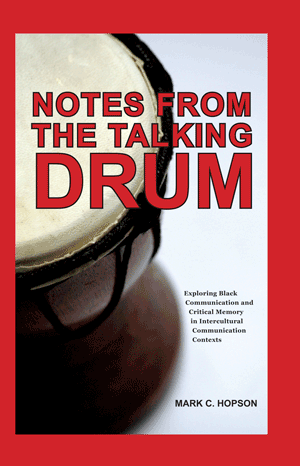Notes from the Talking Drum: Exploring Black Communication and Critical Memory in Intercultural Comm | |
|  | Quantity in Basket:none
Code: 978-1-61289-005-0
Price:$18.95
Title: Notes from the Talking Drum
Sub-title: Exploring Black Communication and Critical Memory in Intercultural Communication Contexts
Author(s): Mark C. Hopson
Publish Date: January 2011
Pages: 128
Format: Paper
| |
| “Dr. Hopson emphasizes the role of critical memory and power dynamics in interracial and intercultural communication processes.”
~Brenda J. Allen, author of Difference Matters: Communicating Social Identity
“Hopson insists that we question knowledge production and circulation. He implores that we thoughtfully consider how we have been domesticated by a pedagogy that has disinvested itself from multiculturalism.”
~Ronald L. Jackson II, co-editor of Understanding African American Rhetoric: Classical Origins to Contemporary Innovations
The purpose of this book is to help readers understand how race and culture can impact communication. More specifically, Hopson explores the ways in which Black/African American communication works as part of a dynamic intercultural and interracial interaction.
A primary aim for Black/African Americans has been to navigate successfully through predominantly White/European American organizational, institutional, and societal structures. The author draws from critical accounts to highlight tensions and strategies for communicators and suggests that rhetorical devices illustrated in classic texts continue to inform intercultural and interracial communication today.
Contents: Foreword, Ronald L. Jackson II. CONCEPTUALIZING THE TALKING DRUM. Situating Black Communication as Intercultural Experience. The Iterativity of Racism. Consciousness. Was Wright Wrong? Critical Memory as Sociopolitical Context. Critical Memory and the Quest to Become the First Black U.S. President. Summary. AFRICAN-CENTEREDNESS, INTERCULTURAL COMMUNICATION, AND CRITICAL MEMORY. Part I: Constructing African-centered Theory. Strengths and Criticisms of African-centered Frameworks. Black Masculinity and Manhood. Black Feminist and Womanist Thought. Critical Race Theory. Theorizing the Black Atlantic. Part II: Overview of Intercultural Communication. Ethnocentrism and Ethnorelativism. Intercultural Communication Paradigms. Co-cultural Communication. Theory. Part III: Power and Privilege. Part IV: Critical Memory as Means and Method for Discovery. Concluding Thoughts on Axiology. THE BLACK GAZE. Gazing at Whiteness. Blackness as Visible-Invisible. Whiteness and Representations of Terror and Abuse. VOICE. Part I: Naming Ourselves. Part II. A Rhetoric of Affirmation. Black Feminist Thought and the Rhetoric of Affirmation. Black Feminist Thought in Happy to be Nappy. Black Hair as Aesthetic. Black Hair as Ascension. Part III: Voice and the Rhetoric of Possibility. Summary. SPACE. Part I: Space and the Color-line. Strategizing Space. Part II: Interpreting Experiences and Moving Toward Ethnorelativism. Race, Privilege, and Whitespace. My Black Masculinist Standpoint Within Whitespace. VOICE, GAZE, SPACE, AND WHY IT MATTERS: A CONCLUDING CRITICAL MEMORY ON THE “THREE RULES OF EPIDEMICS”. Diffusing Race and Gender in Gladwell’s The Tipping Point. Black Men and Disease. Syphilis. HIV. Critical Memory and the Tuskegee Experiment. Conclusion: From Understanding to Action. References. Additional Reading. Author Index. Subject Index.
|
| |







